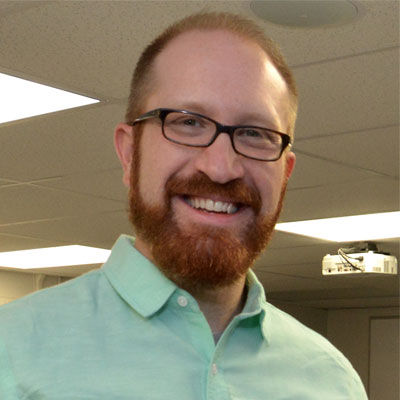
April 2016
Jamie Cohen
(BA, Television Production, '04; MA, Comparative Arts & Culture, '10)
Q & A:
- What was your favorite class, who was your favorite professor, or what is your fondest memory of Hofstra?
While at Hofstra I had a lot of great classes and a lot of great professors, and I have a ton of fond memories. I'd say some of the best memories were from when the TV and film majors got together to produce Thursday Nite Live. I produced the second season way back when. Also, I met my wife while I was at Hofstra, so that makes Hofstra really memorable. - What was your first job after graduating Hofstra, and what was the most valuable thing you learned there?
Right after I graduated from Hofstra, I landed my first job as an assistant editor on a WE TV series called Young, Sexy, & …. The experience afforded me the chance to use the technical skills I gained at Hofstra and apply my ambition toward professional growth. Success in the television industry comes from a healthy mix of ambition and persistence, and I luckily found myself producing segments for NJN the following year. I later left NJN for a producer position at mtvU. - What is your field of specialty, and how did you come to work in the industry?
After my tenure at mtvU, I decided I wanted to pursue visual media education as a career. It is very important for me to both study and teach the theory and frameworks behind the rapidly shifting field of media, and I will always specialize in it, whether I am producing it, teaching it, or studying it. Today, I am a full-time instructor and director of the New Media Program at Molloy College, a program I co-founded. My focus is to educate my students about new and digital media, both theory and practice. It's a great gig; I get to study Internet memes and teach students how to be creators. - What advice would you give Hofstra students?
Always be creating. This is a very opportunistic time in history for content creators to become noticed by broadcasting their passion. Create anything! Show it off! If you are not creating, you are doing yourself a disservice. - In one word, how would you describe Hofstra?
Advantageous. - What made you want to become a professor?
When I was a graduate student, I had role models at Hofstra who gave me opportunities to teach while I was still taking classes. Talking with students, helping them succeed, having meaningful scholarly conversations, and creating activists, that's what makes me feel alive. I love my research. It's amazing to teach, as well as learn along with my students about new media and digital culture. - What kind of changes have you seen in digital media, and where do you see the field moving in the future?
Digital media is ever evolving, and what I look for is how digital media are utilized. In the last decade of YouTube and immense social media growth, we've seen a quick rise of corporate influence in technology growth and cultural integrations. For example, right now VR and immersive media are really cool, but are immobile technology. I look for long-term trends and that seems to be mobility and creativity. I see the future as augmented media: enhancing our environment with digital media visuals, people capturing every moment and movement, remixing and reimagining media creatively. I think we are in the best, most creative time to ever exist, but corporate media know that too. It's up to users, especially students (since you have the "It's for a student project" excuse), to create new and digital media that create civic voices and activism while you still can. The future may have more limited access. - Where do you see yourself in 10 years? Where do you see your career progressing in the future?
I'm currently a full-time PhD student at Stony Brook studying media archaeology and cultural studies. I think new and digital media are moving toward a media archaeology framework. This means thinking critically about digital media in context with the creators and the objects of their production. To put it more clearly, think of an Instagram picture as a physical photograph and put it in context of the image, the software, the platform of Facebook, the field social media, etc. If we are not thinking critically about digital media, we will simply follow someone else's development decisions, not our own. I find it fascinating and important and see myself teaching and researching in media archaeology in the future.

Jamie Cohen is the director and a full-time instructor in the New Media Program at Molloy College. His book Producing New and Digital Media: Your Guide to Savvy Use of the Web (with Thomas Kenney) was published by Focal Press/Routledge in 2015. Prior to working at Molloy College, Jamie was the director of web and digital media at The Lawrence Herbert School of Communication at Hofstra University.
Jamie is published on the subjects of digital media literacy, immersive technology, social media, memes, Internet culture, Web video and online tools, and he presents this research at conferences and invited talks. As a former television producer, he uses his knowledge of the media industries to create informed, savvy leaders in this evolving field.
Currently, Jamie is developing a New Media Academy and collaborative facility between Molloy College and Baldwin High School. He and his wife, Nicole Samartino '09, help to plan an annual event and fundraiser for Hofstra alumni in the Queens and Brooklyn areas called #Hofstoria. He is also currently a full-time doctoral student at Stony Brook University studying cultural studies and media archaeology. Find him on Twitter @NewandDigital.